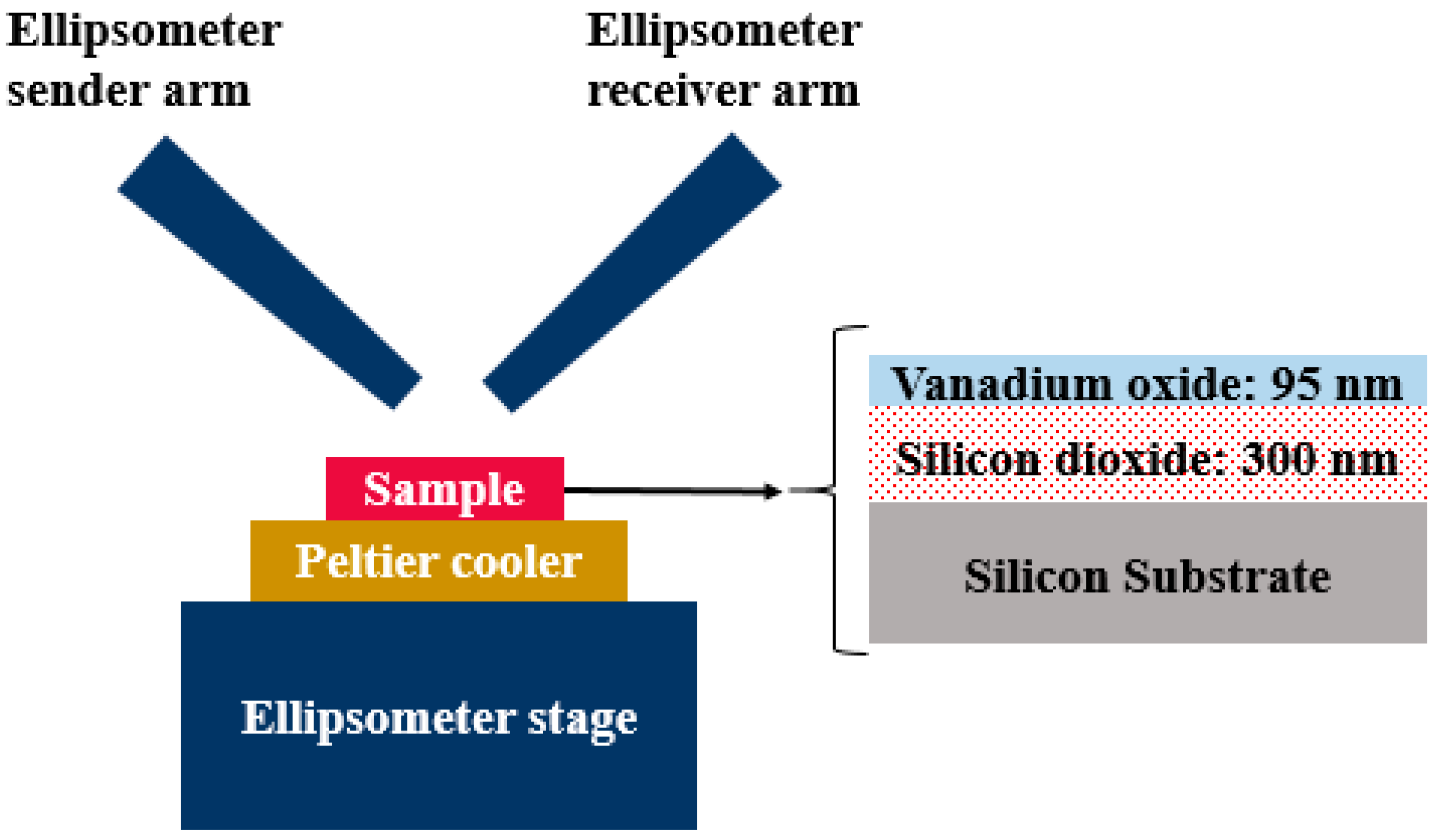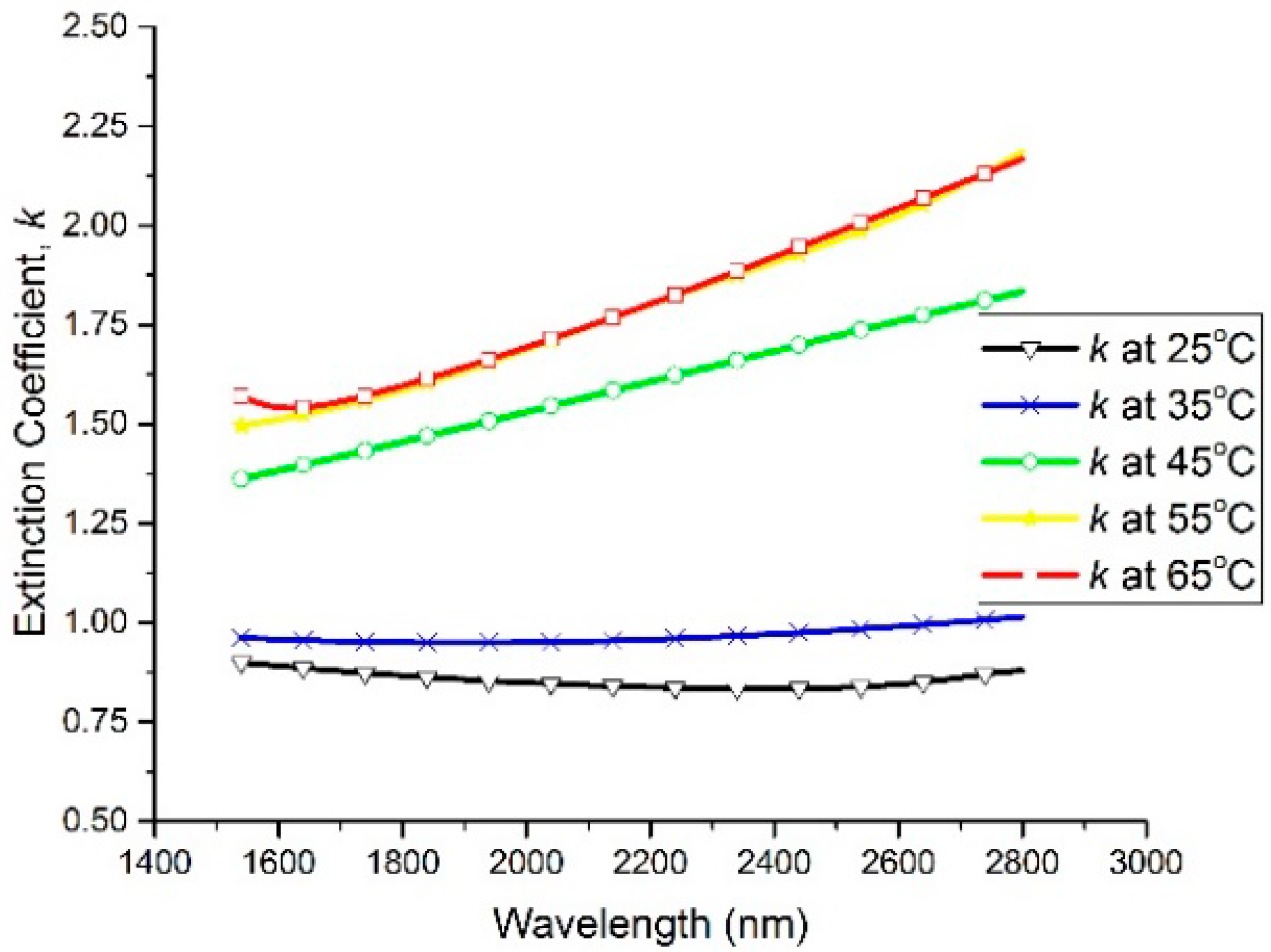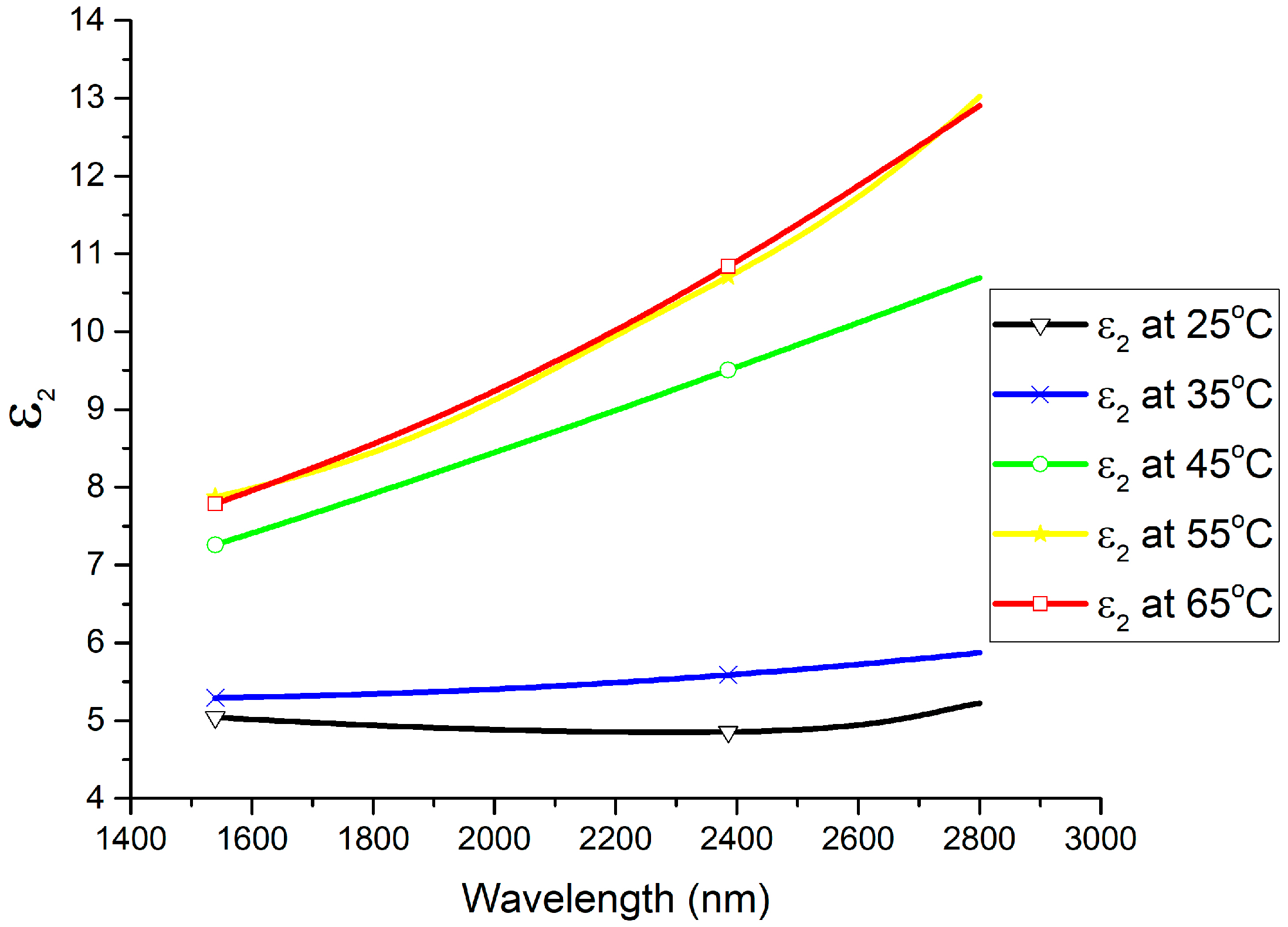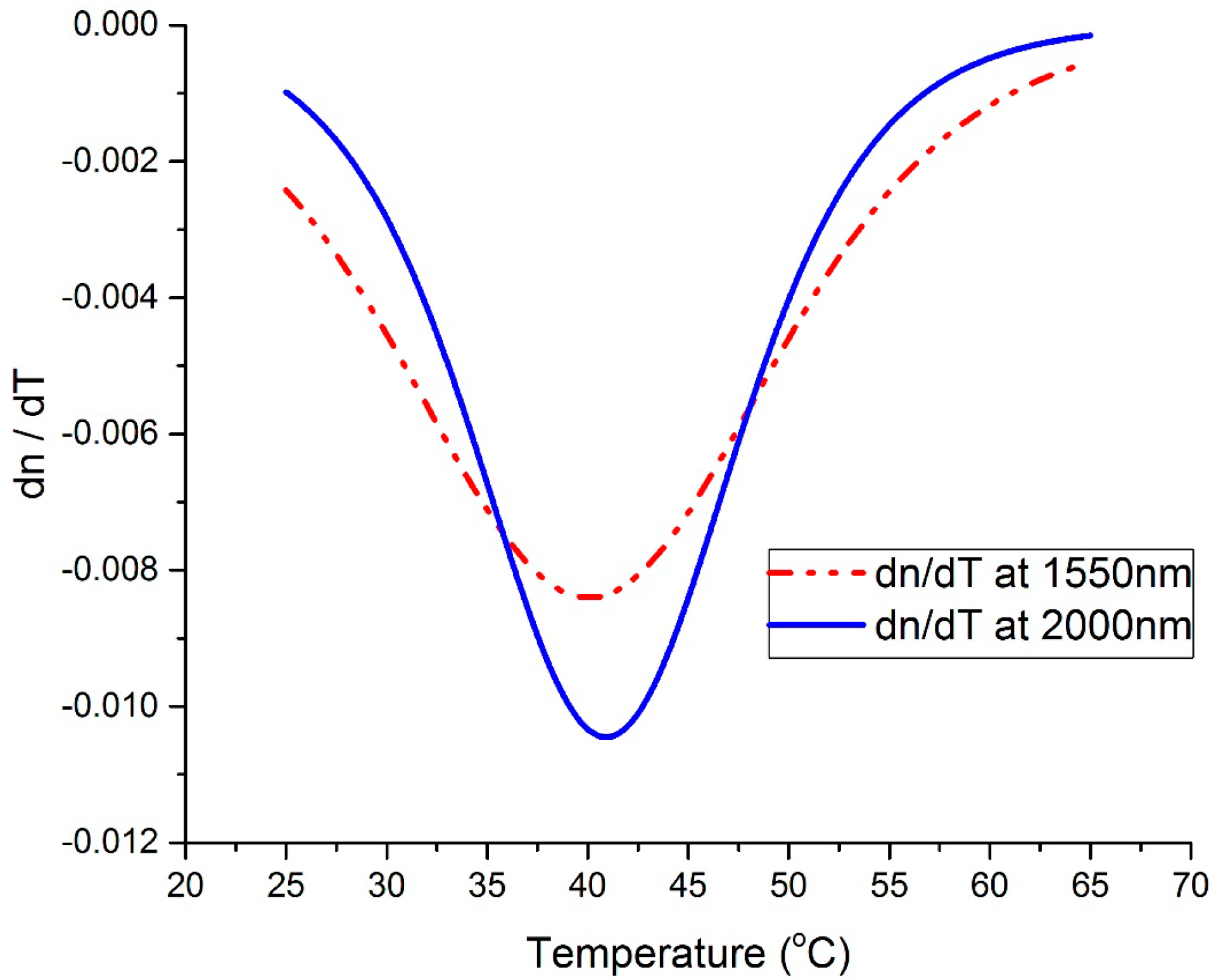Vanadium-Oxide-Based Thin Films with Ultra-High Thermo-Optic Coefficients at 1550 nm and 2000 nm Wavelengths
Abstract
:1. Introduction
2. Film Synthesis and Ellipsometric Data Acquisition
3. Modeling Ellipsometric Data
4. Analysis and Discussion
5. Conclusions
Author Contributions
Funding
Acknowledgments
Conflicts of Interest
References
- Bolle, C.; Sridhar, A.; Safar, H.; Neilson, D.; Cappuzzo, M.; Earnshaw, M.A. Fast and Low-Loss Electromagnetically Tunable Optical Filter. IEEE Photonics Technol. Lett. 2018, 30, 837–840. [Google Scholar] [CrossRef]
- Manganelli, C.L.; Pintus, P.; Gambini, F.; Fowler, D.; Fournier, M.; Faralli, S.; Kopp, C.; Oton, C.J. Large-FSR Thermally Tunable Double-Ring Filters for WDM Applications in Silicon Photonics. IEEE Photonics J. 2017, 9, 1–10. [Google Scholar] [CrossRef]
- Chen, K.; Duan, F.; Yu, Y. High-performance thermo-optic tunable grating filters based on laterally supported suspended silicon ridge waveguide. Opt. Express 2018, 26, 19479–19488. [Google Scholar] [CrossRef] [PubMed]
- Domash, L.; Wu, M.; Nemchuk, N.; Ma, E. Tunable and switchable multiple-cavity thin film filters. J. Light Technol. 2004, 22, 126–135. [Google Scholar] [CrossRef]
- Abdel-Rahman, M. Vanadium Oxide Thin Films with High Midwave & Longwave Infrared Thermo-Optic Coefficients and High Temperature Coefficients of Resistance. Optik 2018, 159, 79–86. [Google Scholar]
- Ilahi, B.; Abdel-Rahman, M.; Zaaboub, Z.; Zia, M.; Alduraibi, M.; Maaref, H. Thermal annealing induced multiple phase in V/V2O5 alternating multilayer structure. Int. J. Mod. Phys. B 2016, 30, 1650210. [Google Scholar] [CrossRef]
- Wooten, F. Optical Properties of Solids; Academic Press: New York, NY, USA, 1972. [Google Scholar]
- Lamsal, C.; Ravindra, N.M. Optical properties of vanadium oxides-an analysis. J. Mater. Sci. 2013, 48, 6341–6351. [Google Scholar] [CrossRef]
- Dar, T.; Agrawal, A.; Kumar, P.; Choudhary, R.; Sen, P. Thermo-optic coefficients of pure and Ni doped ZnO thin films. Thin Solid Films 2016, 603, 115–118. [Google Scholar] [CrossRef]
- Wiechmann, S.; Müller, J. Thermo-optic properties of TiO2, Ta2O5 and Al2O3 thin films for integrated optics on silicon. Thin Solid Films 2009, 517, 6847–6849. [Google Scholar] [CrossRef]








| Temperature | Oscillator Number | ωo (1/cm) | f (1/cm) | Γ (1/cm) |
|---|---|---|---|---|
| 25 °C | 1st | 386,953.06 | 277,272.31 | 219,592.61 |
| 2nd | 3510.58 | 887.41 | 473.66 | |
| 3rd | 40,051.91 | 101,286.24 | 140,403.64 | |
| 35 °C | 1st | 49,062.24 | 127,980.05 | 214,428.97 |
| 2nd | 8084.86 | 26,587.91 | 168,517.97 | |
| 3rd | 3715.14 | 38,778.30 | 359,784.53 | |
| 45 °C | 1st | 304,755.16 | 203,098.52 | 67,040.95 |
| 2nd | 6270.27 | 41,878.19 | 83,629.83 | |
| 3rd | 127,295.33 | 211,269.44 | 399,999.47 | |
| 55 °C | 1st | 4443.55 | 3110.98 | 2020.83 |
| 2nd | 2988.94 | 6828.43 | 1673.94 | |
| 3rd | 37,461.18 | 121,078.52 | 212,566.64 | |
| 65 °C | 1st | 1339.63 | 3648.94 | 456.64 |
| 2nd | 2297.91 | 8245.61 | 2153.14 | |
| 3rd | 31,002.16 | 114,284.49 | 219,101.48 |
| Temperature | ωp (1/cm) | ωτ (1/cm) |
|---|---|---|
| 25 °C | 4404.65 | 4990.92 |
| 35 °C | 4083.51 | 1690.66 |
| 45 °C | 5408.59 | 2742.11 |
| 55 °C | 6325.33 | 421 |
| 65 °C | 1339.63 | 0 |
© 2020 by the authors. Licensee MDPI, Basel, Switzerland. This article is an open access article distributed under the terms and conditions of the Creative Commons Attribution (CC BY) license (http://creativecommons.org/licenses/by/4.0/).
Share and Cite
Abdel-Rahman, M.; Bahidra, E.; Abas, A.F. Vanadium-Oxide-Based Thin Films with Ultra-High Thermo-Optic Coefficients at 1550 nm and 2000 nm Wavelengths. Materials 2020, 13, 2002. https://doi.org/10.3390/ma13082002
Abdel-Rahman M, Bahidra E, Abas AF. Vanadium-Oxide-Based Thin Films with Ultra-High Thermo-Optic Coefficients at 1550 nm and 2000 nm Wavelengths. Materials. 2020; 13(8):2002. https://doi.org/10.3390/ma13082002
Chicago/Turabian StyleAbdel-Rahman, Mohamed, Esam Bahidra, and Ahmed Fauzi Abas. 2020. "Vanadium-Oxide-Based Thin Films with Ultra-High Thermo-Optic Coefficients at 1550 nm and 2000 nm Wavelengths" Materials 13, no. 8: 2002. https://doi.org/10.3390/ma13082002
APA StyleAbdel-Rahman, M., Bahidra, E., & Abas, A. F. (2020). Vanadium-Oxide-Based Thin Films with Ultra-High Thermo-Optic Coefficients at 1550 nm and 2000 nm Wavelengths. Materials, 13(8), 2002. https://doi.org/10.3390/ma13082002





